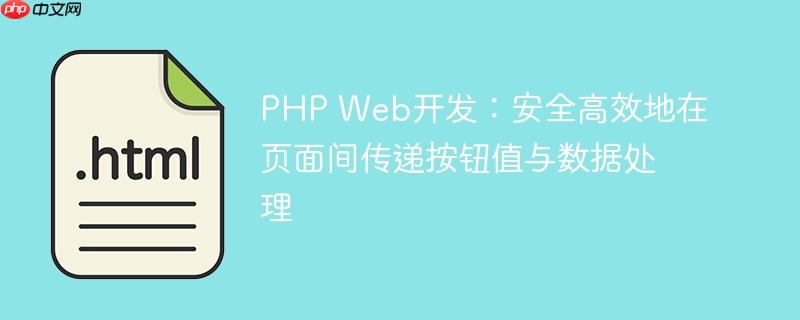
在web应用中,当用户点击一个html按钮时,我们常常需要将该按钮关联的特定数据(例如,一个id)传递给服务器端的php脚本,以便php能够根据这个数据执行相应的逻辑,如从数据库查询相关信息。
原始问题中尝试使用localStorage在JavaScript中存储按钮值,然后通过JavaScript在目标页面读取。虽然localStorage可以实现客户端数据的持久化,但PHP作为服务器端语言,在页面首次加载时无法直接访问客户端的localStorage数据。PHP处理请求是在服务器上完成的,而localStorage是浏览器本地存储。因此,我们需要一种机制,能够将客户端的数据随着HTTP请求一起发送到服务器。
解决此问题的核心在于利用HTTP协议的特性,将数据作为请求的一部分发送到服务器。常用的方法有两种:URL参数(GET请求)和表单提交(GET或POST请求)。
URL参数是GET请求最常见的传值方式。当通过URL传递数据时,数据会附加在URL的末尾,以问号?开始,参数之间用和号&连接。在PHP中,可以通过全局数组$_GET来获取这些参数。
在生成按钮时,我们不再依赖onclick事件中的localStorage,而是修改JavaScript函数,使其在点击时直接构建带有参数的URL并进行跳转。
立即学习“PHP免费学习笔记(深入)”;
HTML/PHP 部分 (index.php):
<?php
$con = mysqli_connect("localhost", "root", "", "lectureHub");
if(!$con) {
die("Could not connect to MySql Server:" . mysqli_error($con));
}
$query = "select * from lectures";
$result = mysqli_query($con, $query);
if ($result->num_rows > 0) {
while($row = $result->fetch_assoc()) {
$lec_id = htmlspecialchars($row['lec_id']); // 确保输出安全
$lec_name = htmlspecialchars($row['lec_name']); // 确保输出安全
echo "<button type='button' class='btn btn-outline-primary lecture'
value='{$lec_id}'
onclick='redirectToChapters(this)'>
{$lec_name}
</button> ";
}
} else {
echo "<p>0 results</p>";
}
mysqli_close($con);
?>JavaScript 部分 (在 index.php 或外部 JS 文件中):
function redirectToChapters(buttonElement) {
const lecId = buttonElement.value; // 获取按钮的value属性值
// 构建目标URL,将lec_id作为GET参数传递
// 例如:chapters.php?lec_id=123
location.href = `chapters.php?lec_id=${encodeURIComponent(lecId)}`;
}说明:
在chapters.php文件中,PHP脚本可以通过$_GET超全局数组来访问lec_id参数。
PHP 部分 (chapters.php):
<?php
$con = mysqli_connect("localhost", "root", "", "lectureHub");
if(!$con) {
die("Could not connect to MySql Server:" . mysqli_error($con));
}
$lecId = null;
// 检查$_GET['lec_id']是否存在,并获取其值
if (isset($_GET['lec_id'])) {
// !!! 安全提示:在使用GET参数进行SQL查询前,务必进行输入验证和清理 !!!
// 以下使用mysqli_real_escape_string进行简单清理,更推荐使用预处理语句
$lecId = mysqli_real_escape_string($con, $_GET['lec_id']);
}
echo "<p id='lecIdDisplay'>Lecture ID: " . htmlspecialchars($lecId ?? 'Not Provided') . "</p>";
if ($lecId) {
// 构建SQL查询,使用获取到的lecId
$query = "SELECT * FROM chapters WHERE lec_id = '$lecId'";
$result = mysqli_query($con, $query);
if ($result) {
if ($result->num_rows > 0) {
echo "<h2>Chapters for Lecture ID: " . htmlspecialchars($lecId) . "</h2>";
echo "<ul>";
while($row = $result->fetch_assoc()) {
echo "<li>" . htmlspecialchars($row['chapter_name']) . "</li>"; // 假设有chapter_name字段
}
echo "</ul>";
} else {
echo "<p>No chapters found for this lecture ID.</p>";
}
} else {
echo "<p>Error executing query: " . mysqli_error($con) . "</p>";
}
} else {
echo "<p>Lecture ID was not provided or is invalid.</p>";
}
mysqli_close($con);
?>安全注意事项:
表单提交是另一种常见的数据传递方式,它可以是GET或POST请求。对于按钮点击,我们可以将按钮放置在一个表单中,并使用隐藏的输入字段来传递值。
为每个按钮创建一个独立的表单。当按钮被点击时,实际上是提交了该表单。
HTML/PHP 部分 (index.php):
<?php
$con = mysqli_connect("localhost", "root", "", "lectureHub");
if(!$con) {
die("Could not connect to MySql Server:" . mysqli_error($con));
}
$query = "select * from lectures";
$result = mysqli_query($con, $query);
if ($result->num_rows > 0) {
while($row = $result->fetch_assoc()) {
$lec_id = htmlspecialchars($row['lec_id']);
$lec_name = htmlspecialchars($row['lec_name']);
// 为每个按钮创建一个表单
echo "<form action='chapters.php' method='get' style='display:inline-block; margin-right: 10px;'>";
// 使用隐藏输入字段传递lec_id
echo "<input type='hidden' name='lec_id' value='{$lec_id}'>";
// 按钮作为提交按钮
echo "<button type='submit' class='btn btn-outline-primary lecture'>";
echo $lec_name;
echo "</button>";
echo "</form>";
}
} else {
echo "<p>0 results</p>";
}
mysqli_close($con);
?>说明:
如果表单method是get,则在chapters.php中使用$_GET接收;如果method是post,则使用$_POST接收。其余处理逻辑与方法一类似。
PHP 部分 (chapters.php):
<?php
$con = mysqli_connect("localhost", "root", "", "lectureHub");
if(!$con) {
die("Could not connect to MySql Server:" . mysqli_error($con));
}
$lecId = null;
// 根据表单的method属性,使用$_GET或$_POST
if (isset($_GET['lec_id'])) { // 如果表单method="get"
$lecId = mysqli_real_escape_string($con, $_GET['lec_id']);
}
// else if (isset($_POST['lec_id'])) { // 如果表单method="post"
// $lecId = mysqli_real_escape_string($con, $_POST['lec_id']);
// }
echo "<p id='lecIdDisplay'>Lecture ID: " . htmlspecialchars($lecId ?? 'Not Provided') . "</p>";
if ($lecId) {
// ... 后续的SQL查询和结果显示逻辑与方法一相同 ...
// 推荐使用预处理语句:
$stmt = $con->prepare("SELECT * FROM chapters WHERE lec_id = ?");
if ($stmt) {
$stmt->bind_param("s", $lecId); // "s" 表示参数类型为字符串,根据实际数据类型调整
$stmt->execute();
$result = $stmt->get_result();
if ($result->num_rows > 0) {
echo "<h2>Chapters for Lecture ID: " . htmlspecialchars($lecId) . "</h2>";
echo "<ul>";
while($row = $result->fetch_assoc()) {
echo "<li>" . htmlspecialchars($row['chapter_name']) . "</li>";
}
echo "</ul>";
} else {
echo "<p>No chapters found for this lecture ID.</p>";
}
$stmt->close();
} else {
echo "<p>Error preparing statement: " . $con->error . "</p>";
}
} else {
echo "<p>Lecture ID was not provided or is invalid.</p>";
}
mysqli_close($con);
?>推荐:使用预处理语句(Prepared Statements) 在上述chapters.php的表单提交示例中,我引入了预处理语句的用法。这是防止SQL注入的最佳实践:
将HTML按钮值传递到PHP后端进行处理是Web开发中的常见需求。通过本文介绍的两种主要方法——URL参数(GET请求)和表单提交(GET/POST请求),开发者可以安全高效地实现这一目标。选择哪种方法取决于具体的使用场景和需求,但无论选择哪种,都必须牢记数据安全的重要性,特别是防止SQL注入和XSS攻击。遵循这些最佳实践,将有助于构建健壮和安全的Web应用程序。
以上就是PHP Web开发:安全高效地在页面间传递按钮值与数据处理的详细内容,更多请关注php中文网其它相关文章!

PHP怎么学习?PHP怎么入门?PHP在哪学?PHP怎么学才快?不用担心,这里为大家提供了PHP速学教程(入门到精通),有需要的小伙伴保存下载就能学习啦!

Copyright 2014-2025 https://www.php.cn/ All Rights Reserved | php.cn | 湘ICP备2023035733号